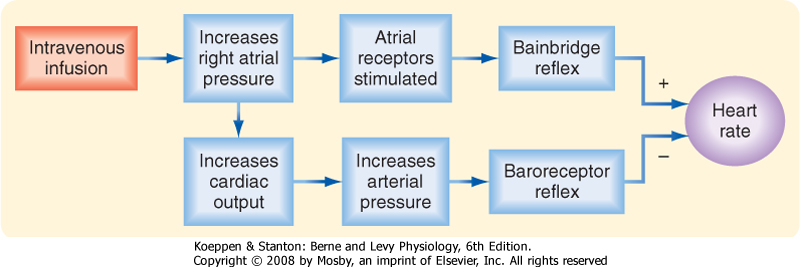Bainbridge-Reflex
The Bainbridge reflex is a 1915 by Francis Arthur Bainbridge ( 1874-1921 ) described reflex, in which, after a sudden increase in blood volume ( infusion of saline or blood transfusion ), an increase in heart rate is observed. This effect was detectable at different arterial blood pressure, but the elongation of the right cardiac atrium ( with an increase in central venous pressure ) and intact nerve connection to the circulation center ( vagus nerve ) dependent.
It was later discovered that the reflex response depends on the initial situation: at low stroke rate ( bradycardia) increases volume administration the heart rate, but this decreases when the same at a high output rate (tachycardia ) occurs.
This is due to the increased pressure in the right atrium through the increase in blood volume. This solves two antagonistic reflex patterns from:
- Stretch receptors in the atria excited about the Bainbridge reflex to the sinus node and is frequency -enhancing.
- However, the Frank -Starling mechanism also raises stroke volume and thus the ( systolic ) blood pressure. The baroreceptor reflex then inhibits the sinus node and is frequency -reducing.
This results in a double feedback loop with opposite frequency effect. What effect predominates depends on the current cycle situation - especially the blood volume - from:
- With a small volume of blood ( for blood loss ), the stroke volume increases with replenishment of the cycle - towards normovolemia ( Infusionstherapie! ) - to and from the heart rate at the same time ( baroreceptor reflex ).
- With increased blood volume ( hypervolemia ), however, further increase in volume causes no increase in stroke volume more, but probably tachycardia ( Bainbridge reflex). This " tries " the heart " work off " the high blood supply of the beat frequency.
The two reflexes complement each other so that they get the circulation in the optimal center area.
- Reflex
- Cardiology










